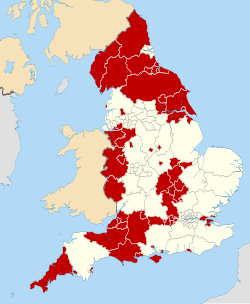History
The town of Blackburn was governed by a body of improvement commissioners from 1803. [5] The town was incorporated to become a municipal borough in 1851, after which it was governed by a body formally called the 'mayor, aldermen and burgesses of the borough of Blackburn', generally known as the corporation, town council or borough council. [6] When elected county councils were established in 1889, Blackburn was considered large enough for its existing council to provide county-level services, and so it was made a county borough, independent from the new Lancashire County Council, whilst remaining part of the geographical county of Lancashire. [7]
A larger Blackburn district was created in 1974 under the Local Government Act 1972. It gained the neighbouring town of Darwen and several other rural parishes, and became a non-metropolitan district, with Lancashire County Council providing county-level services. [8] [9] Blackburn's borough status was transferred to the enlarged district, allowing the chair of the council to take the title of mayor, continuing Blackburn's series of mayors dating back to 1851. [10]
The borough was renamed Blackburn with Darwen in May 1997. [11] [12]
The council became a unitary authority on 1 April 1998. The way the change was implemented was to create a new non-metropolitan county covering the same area as the borough, but with no separate county council; instead, the existing borough council took on county council functions. [13] Blackburn with Darwen remains part of the ceremonial county of Lancashire for the purposes of lieutenancy. [14]
In 2025, the council became a member of the new Lancashire Combined County Authority. [15]
Governance
As a unitary authority, Blackburn with Darwen Borough Council provides both district-level and county-level functions. Parts of the borough are covered by civil parishes, which form an additional tier of local government for their areas. The exceptions are the main part of the Blackburn urban area (roughly corresponding to the pre-1974 borough) and the Hoddlesden area, which are unparished. [16] [17]
Political control
The council has been under Labour majority control since 2011.
Political control of the council since the 1974 reforms has been as follows: [18] [19]
Lower tier non-metropolitan district
Unitary authority
Leadership
The role of mayor is largely ceremonial in Blackburn with Darwen. Political leadership is instead provided by the leader of the council. The leaders since 1989 have been:
Composition
Following the 2024 election the composition of the council was: [36]
Of the independent councillors, 12 sit together as the '4 BwD' group, and the other does not belong to a group. [37] The next election is due in May 2026. [38]
This page is based on this
Wikipedia article Text is available under the
CC BY-SA 4.0 license; additional terms may apply.
Images, videos and audio are available under their respective licenses.


